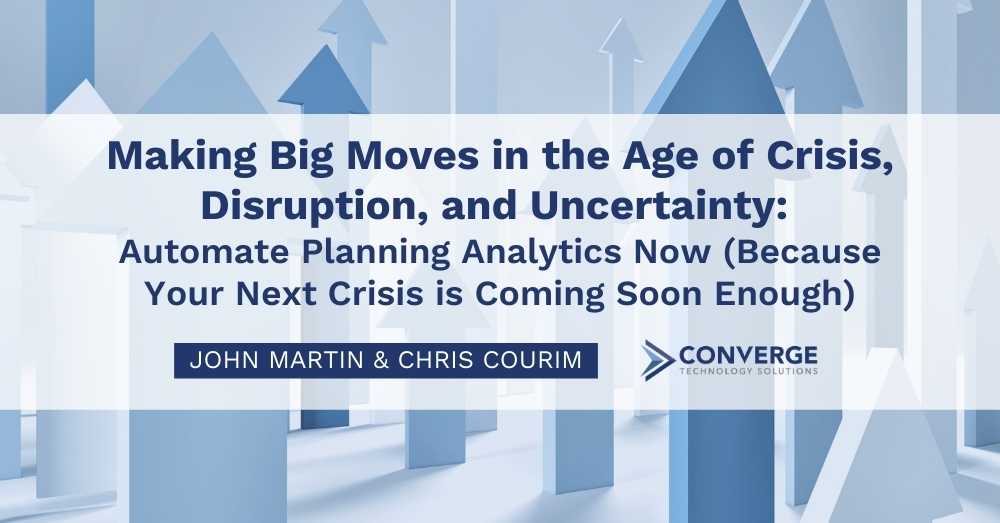In terms of business lessons to be learned, the COVID-19 pandemic and the resulting interventions taught us lot. It caught a lot of us off guard, and businesses had to react quickly.
Throughout the ordeal, business as usual changed dramatically. Companies saw demand get killed in some areas as cities locked down, while other aspects of their business saw demand spikes as new contactless business models were raced into place and companies accelerated their digitization efforts. Supply chains were rocked, blocked, and diverted, creating unexpected shortages and overages. Workers were sent to work from home, offices stood empty, business travel stopped, employees were furloughed, and the list goes on.
From a financial planning and analysis perspective, the moment the COVID world hit, the planning function was completely stressed. All of the projections and best guesses about the present and immediate future were bunk.
What about our data going forward? Is the data from 2020’s unusual year worthless to us for planning going forward because it was so different? Or is it more valuable, since we’ve now seen our businesses under radically different circumstances?
Either way, the crisis taught many of us a couple of valuable business lessons:
- Big changes and shocks can and will happen to businesses. Even when COVID is finally over, we don’t know what the next thing may be. Hopefully it won’t be another virus, but it could be some other black swan that comes from nature or politics or human error. Or it might just affect your business, be it an unseen competitor, a supply chain issue, a new regulation, a wild change in customer preferences, or…who knows?
- Most traditional financial and operational planning and analysis is way too slow to react to significant change. With spreadsheets and manual data manipulation, most FP&A takes too long, requires too many resources, and creates its own business risk. Many companies have a planning process that lasts two months or more. Even without disaster-level disruptions, the everyday planning and maintenance of business needs to be responsive and agile. The old ways don’t cut it.
One of the companies we work with found themselves on the ‘boom’ side of COVID, and along with it, some trouble capitalizing on it. As an online retailer of home exercise equipment, huge demand for consumer equipment sales went up as people sheltered at home, stopped going to the office, and were either forbidden or too concerned to go the gym. A huge surge of sales would normally be a boon, but the global supply chain was severely hampered. Most of the equipment was manufactured in China and the pandemic had shut down factories, altered shipping routes, changed upstream availability of parts and materials, and other factors. The company was now competing with other companies for inventory. The delays ended up causing significant customer service issues, hence flooding their call centers and email with service inquiries. The delays would affect how marketing and demand generation investments would be made.
The COVID-caused boom caused emergencies in financial planning and analysis across the board. Resources needed to be shifted to handle service issues while realistic expectations of offering equipment for sale, understanding inventory levels, setting delivery schedules, etc., were all in flux. The data that they leveraged for making projections and investment decisions was completely different during this period. They needed the tools and data discipline to react quickly to market, supply chain, and customer dynamics. They adopted a new FP&A toolset and approach that would use AI and automation to vastly improve their planning processes, shifting a planning process that would take over 60 days down to just 10. They also implemented bot technology to handle their customer service volume surges.
COVID pressured them to get agile. Quickly.
Let’s take a look at another instance. For many companies, COVID brought a downturn and some forced business model pivots. A fast-fresh restaurant chain we worked with found the COVID lockdowns to be severe as all in-store dining was halted. Their restaurants were typically near office parks and the like to cater to workers on their lunch breaks, which further reduced business. They lost most of their corporate catering business. They had to pivot quickly to a more robust take-out and delivery offering and move into new modes of business such as take-home meal kits. Despite doing all they could, layoffs and furloughs at both the restaurant level and headquarters were still needed. The finance team now had more complex work to do and more analysis to perform – all with a smaller team to do it.
They implemented IBM Planning Analytics for seven power users and 20 other finance professionals in different departments, developing three main data cubes that the team would use for reporting and analytics. The new implementation replaced a largely manual system of Google Sheets, allowing all users to now pull all their data through TM1 and enabling them to update their forecasts from the same book. Previously, the forecasts were created separately by cost center and had to be reconciled manually.
The solution provided many benefits. Planning cycles went from long, multi-week cycles to just one week. Reporting and forecasts were more accurate and different analysts had the same data to work with. The move was also a cost reduction play. The system freed up resources, so it felt like they had added new analysts to the team despite the smaller headcount they had to work with. The smaller team could do more than the previous larger, manual-based team.
In both companies’ cases, adopting a FP&A solution with AI and automation was key to transforming their planning function to be quick and agile amidst wild business fluctuations. In both cases, it was critical that they didn’t just lift-and-shift their old processes onto new technology. It was essential to design a new, better process that the new technology optimally enabled. Automation of the FP&A function allowed decision-makers to react more quickly, more accurately, and often with fewer resources.
Was COVID necessary to push these companies to adapt their financial planning approach rapidly? It certainly made the case more compelling and urgent. While the case for Planning Analytics is clear when things are going smoothly, the future is never always going to be smooth, and the next planning crisis, big or small, known or unknown, is always around the corner. Smart companies should be investing in planning analytics and automation ahead of the curve.





